How to choose a loft bed?
Categories:
Children's Room
 Choosing the right baby blanket dimensions according to season and age
Choosing the right baby blanket dimensions according to season and age
 How to attach a headboard (with or without drilling): quick and effective soluti
How to attach a headboard (with or without drilling): quick and effective soluti
 Waterproof sheet or mattress protector: the best solution by age group
Waterproof sheet or mattress protector: the best solution by age group
 27 Original, Useful, and Trendy Christmas Ideas for Teens 2025
27 Original, Useful, and Trendy Christmas Ideas for Teens 2025
 Christmas Activities for Baby: Creative Ideas for Home & Daycare
Christmas Activities for Baby: Creative Ideas for Home & Daycare
The loft bed is an ideal solution to save space in a child's room or in a teenager's room. But how do you choose the right one to meet your needs? Here are our tips for making the right selection.
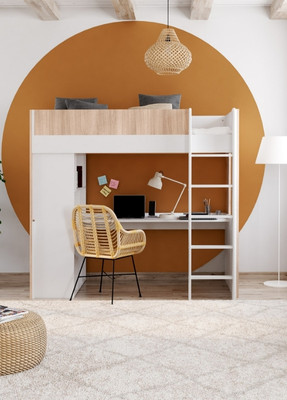
The primary reason parents decide to furnish a child's room with a loft bed is the significant space saving. However, even in a fairly spacious room, children love this type of bed. They quickly get used to sleeping at height and enjoy dominating their space. The child considers their elevated bed as a treehouse where they can find refuge at nightfall.
As for the available space below the bed, it can serve different functions: desk, play area, small lounge with small seats and cushions, library and reading corner, etc. The child can also hang a sheet to create a removable partition and transform this space into a den.
The child must be at least 6 years old before sleeping in a loft bed. Talk about it with them before buying to reassure them and highlight the advantages, especially the space saving.
The loft bed is equipped with a guardrail that must be high enough so that the child is not at risk of falling. However, if your child is worried about sleeping at height, you can buy them a convertible loft bed model. It can be assembled as a classic bed, then at a medium height, before being installed at its maximum height. When it's at mid-height, the child can already play in the space below and sit there. However, there won't be enough space to put a desk or any other furniture.
Before purchasing the loft bed, it is important to carefully study the room's configuration to decide where it will be installed. Measure the room to ensure the bed won't interfere with the opening of doors and windows.
Since the bed is elevated, it is advisable to place it against at least one wall, or even two if you can fit it in a corner. This also allows you to fix it to the wall, which is safer for the child.
You must have sufficient ceiling height. Take careful measurements if, for example, the room is under the roof and the ceiling is sloped. The child must at least be able to sit up in their bed without hitting their head.
The classic height of a loft bed is 1.75 meters. Check with your ceiling height if there remains at least 70 centimeters.
The standard dimension of a loft bed is 90 x 190 centimeters. However, as children tend to grow taller, the bed is also available in 90 x 200 centimeters. While there is a minimum age of 6 years, there is no maximum age, and you can keep the loft bed for a teenager and even an adult. If you think your child will be tall, it's better to choose the 90 x 200 centimeters bed.
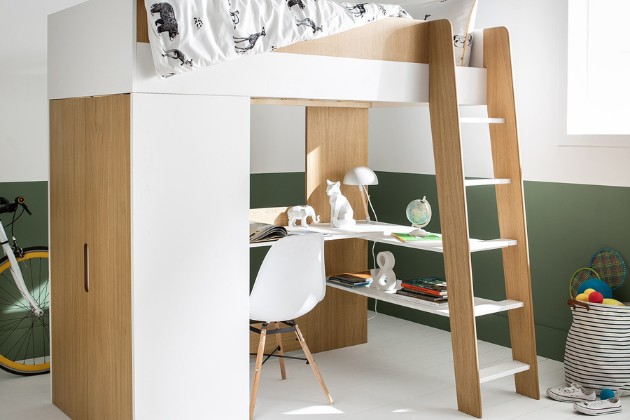
Now that you have ensured you have the necessary space, you need to choose the raw material from which the loft bed is made.
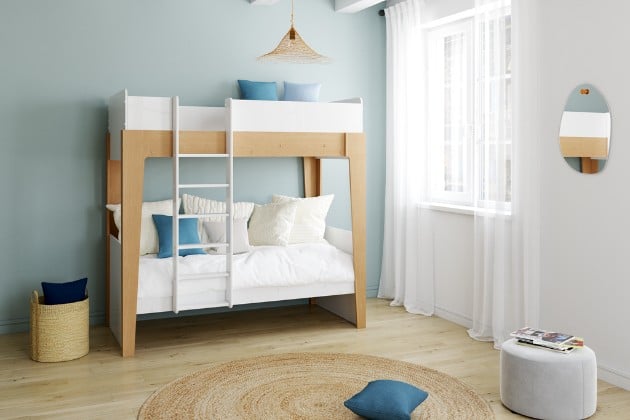
Wood is the most popular material for bedding. It is sturdy, healthy, and its warm touch is very pleasant. The most commonly used species are pine, fir, or spruce. The posts sections must measure between 6.5 and 9 centimeters to ensure good stability. The reliability of wood is impeccable, and your bed will last for decades without ever failing you.
The wood can be kept natural or stained in a wide range of colors.
There are metal loft beds available. However, you must be very careful about their sturdiness. Wall mounting is often mandatory, which is not the case with wood. Additionally, metal is less pleasant, and you will be more limited in designs and colors.
Some loft beds are designed for a specific use, others are not furnished, allowing you to choose your own layout. In any case, if your child plans to read or do homework, remember to install lighting under the bed. Good lighting is essential to avoid straining the eyes.
You can choose a loft bed with wardrobe. This provides you with a closet to store clothes, household linen, and even toys.
The wardrobe ensures excellent stability for the bed.
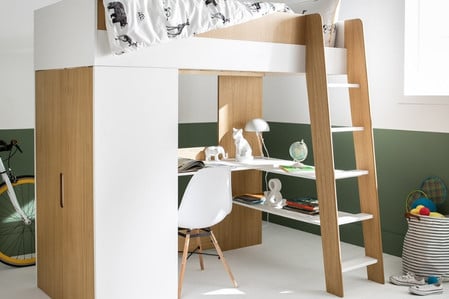
The other possible included furnishing is the desk. A shelf along the entire length of the bed offers a large space that can be complemented by other shelves and drawers on the side for storage. The loft bed with desk is ideal for children entering middle school or students who need to arrange a small space.
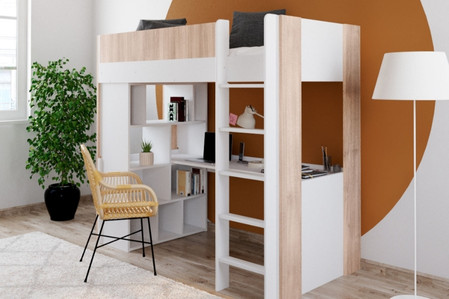
If you buy a loft bed without included furnishings, you can arrange the space under the bed with a bench and cushions.
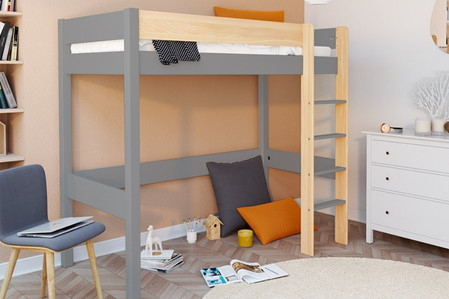
The loft bed mattress must be of excellent quality. Favor natural, hypoallergenic, and dust mite resistant raw materials. The mattress must be made with breathable materials that prevent the child from sweating.
A mattress's quality doesn't depend on its thickness, but rather its density. For a loft bed, it's in your best interest to opt for the thinnest possible mattress to save space under the ceiling. You can find dense yet soft and comfortable mattresses with thicknesses ranging from 6 to 14 centimeters.
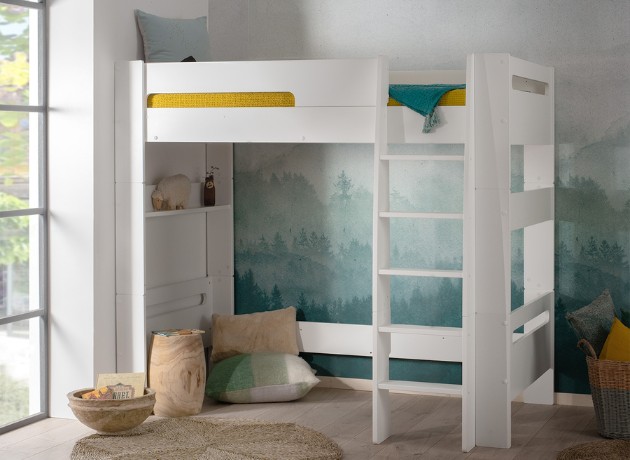
Latex is very common in mattress manufacturing. It is a natural raw material extracted from the rubber tree, also called hevea. Latex is naturally hypoallergenic and dust mite resistant. It is very comfortable and perfectly suitable regardless of the child's age.
Latex has cells that allow for mattress ventilation and help regulate temperature well.
Coconut fiber is rarely used alone, as it is quite rigid and uncomfortable. It is most often combined with latex. Be careful to select a high-end manufacturer, as you otherwise risk buying a mattress that is not homogeneous and not always very comfortable.
The advantage of this type of fiber is that it is naturally hypoallergenic and dust mite resistant.
There are 3 types of foam that differ in their resilience. This specifically refers to the foam's ability to return to its original shape when you stop putting weight on it. The foam is made up of cells copying the shape of those that bees build in their hive.
You have the choice between:
1. low resilience polyester foam;
2. medium resilience polyurethane foam;
3. high resilience viscoelastic foam (memory foam).
For a child, polyurethane foam proves to be the most suitable. It is lightweight, which is practical when making the bed.
There are still some mattresses made with wool, but they are increasingly rare. Wool is not recommended for loft beds because it is quite heavy, which becomes a hindrance when making the bed at height.
The ticking is the fabric covering of the mattress. It must be breathable to help the child manage their temperature and quickly evacuate any trace of perspiration. It is preferable that the ticking be removable for regular washing.
Choose a natural hypoallergenic and dust mite resistant fabric, such as viscose or bamboo.
Safety is paramount for a loft bed. In France, any elevated bed — that is, above 60 centimeters — is subject to strict regulations.
To ensure your loft bed complies with current standards, you must verify that it bears the mentions: "compliant with safety requirements" (in written form or as a pictogram) and that it complies with standard D62100-1/2 which defines dimensional and mechanical safety specifications (resistance and durability) for loft beds.
It must also be notified in written form or with a pictogram that "elevated sleeping is not suitable for children under six years of age".
The elevated sleeping area must be equipped with safety barriers that go all around the bed, except for the opening for bed access by the ladder.
The height between the safety rails and the bed floor must be at least 26 centimeters. After installing the mattress, you must maintain a height of at least 16 cm between the top of the mattress and the top of the railing.
